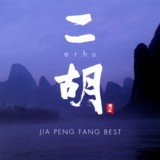|

PMR-0037 |
erhu /
JIA PENG FANG Best
01.
Sirius from "FARAWAY..."
|
Erhu (Niko), which has now grown to be an instrument familiar to most music buffs, increased in recognition and popularity with the American audience after the release of Jia Peng Fang's album "RIVER." Many people believe the Erhu and Kokyu are the same instrument, but the Erhu is a Chinese folk instrument while Kokyu is of a Japanese origin. In addition, Kokyu has three chords (as opposed to the two on the Erhu) and the shape is a lot closer to the Japanese instrument shamisen.

Erhu has a history of about a thousand years. It is said that the instrument originated in the northern part of China. A bow, made with fibers from the horse’s tail, is characteristically placed over the two steel chords and then the bow is rubbed against the chords to produce sounds. Instruments that produce sounds by rubbing the bow against chords, known as "rubbed string instruments," are found world-wide. And just as the violin is its representative instrument in Europe, Erhu is its representative in the East. Erhu is known as the "violin of the Orient." JIA PENG FANG was born in the year 1958 in the town Jams in the Helong Jiang Province of China, and got his first Erhu at the age of eight in 1965 - the year that marked the start of the Cultural Revolution. Jams, a town about thirty hours by train from Beijing, situated close to the Russian border, was not excluded from the ravages wrought by the Cultural Revolution. In fact, how Jia chanced upon the Erhu was through his enlistment into the Maoist Propaganda Corp. When he was sixteen, he was helped by his brother to travel to Beijing to study with professional Erhu players. At that time in China, people were not permitted to move their registers, and it was not possible for someone in the village to simply move into the city. From the ages of sixteen to eighteen, Jia could not get his food rations but made himself a small enclosure, about a meter big on his aunt's veranda and devoted himself to practicing his Erhu day in and day out. He was determined to become a professional Erhu player. In time, he became good enough to play the sub for the teacher he was studying under. But on the date of the exam for enlisting in the Navy Song and Dance Band, the great Karasan Earthquake struck and the exam was canceled, destroying Jia's hope of joining. About half a year later, as a part of the Cultural Revolution Policy, he was forced back to his homeland Jams to labor on the farmland. After the Cultural Revolution blew over and the country settled down, a letter reached him. It was from Jia's former teacher advising him to enter the music academy. After going back to Beijing, he was chosen from among over five hundred applicants to enter the Central Music Academy’s Folk Music Department. An examiner at the examination, a concert master of the China Central Folk music Orchestra, strongly suggested that Jia should try out for their orchestra. He arranged for Jia’s registry in the city and made sure he would be paid for his living expenses. Suddenly Jia found himself starting a life of a professional Erhu player. Jia busied himself rediscovering the traditional arts, which had been denied by the Cultural Revolution, as he continued his enlightening performances as an Erhu soloist and then a sub concertmaster of the orchestra. Then in 1988, to seek new possibilities for his music, he left for Japan with just a suitcase in one hand and his Erhu in the other. He took on many kinds of part time work until his first break came, through meeting with the musician Katsuhisa Hattori. Hattori fell in love with Jia's talent and the tones of the Erhu and invited him to take part in his album productions and concert activities, thereby expanding Jia's world of musical activities. Jia entered around this time in the Master of Arts Degree Program in Music at the Tokyo University of Arts. In 1997, his brilliant co-performance with the orchestra at Carnegie Hall in New York solidified his position in the world of music. Also in June of 1998, he made his debut album "RIVER" with the Pacific Moon label, which blended Western music with the Chinese folk instrument. The high quality of the work won him a high acclaim in Japan and abroad, as well as proving to be a commercial success. In 1999, the concept was further developed in the Pacific Moon album "RAINBOW." It proved to be even more successful than the first album, both in Japan and abroad. The third album from Pacific Moon, "FARAWAY...", was released in January of 2001. This "Best Album" contains a selection from the first three albums, and also the recording of the co-performance with the pianist Naoyuki Onda, live from the studio of the American national FM program "Echoes." Presently, Jia is teaching how to play the Erhu to over a hundred students as he continues to work in the genres of jazz, classics, making movie sound tracks, conducting live stage performances, recording and pursuing the unending potentials of his music. |
